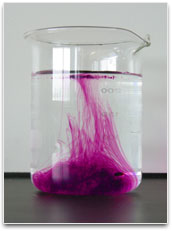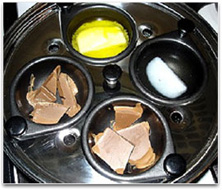This focus idea is explored through:
Contrasting student and scientific views
Student everyday experiences
 For many students at this level, melting and dissolving are seen as indistinguishable. Although two materials are required for the dissolving process, students tend to focus only on the solid and they regard this process as similar to ‘melting’.
For many students at this level, melting and dissolving are seen as indistinguishable. Although two materials are required for the dissolving process, students tend to focus only on the solid and they regard this process as similar to ‘melting’.
Because students have limited experience of materials solidifying at warmer temperatures they often consider that freezing of all materials only takes place at cold temperatures such as in the refrigerator or freezer.
Students consider that sugar melts when it dissolves in water. Often melting is considered to be substances turning into water. This is further reinforced because children see heat being involved in both processes - they know if you want to dissolve more sugar you warm up the water.
Because in many cases it is no longer possible to see the dissolved substance after dissolving (such as salt or sugar dissolved in water), students frequently consider the salt/sugar has just disappeared.
Frequently students will hold views such as:
- the dissolved substance (solute) in a
solution is not taking up any space
- only the taste and/or colour is left when something dissolves, not the substance itself
- substances change into new substances when they dissolve.
Scientific view
Melting and freezing of materials is dependent on their temperature. When something melts the liquid is the same substance as the solid. Not all solids melt on heating (they may burn or decompose).
When something dissolves an additional substance (the
solvent) is needed. Dissolving can involve chemical changes (for example, antacid tablets mixing with water or metal dissolving in acid).
Critical teaching ideas
- Melting and dissolving are not the same.
- In melting only one substance is involved and the liquid and solid are the same material. Heat is needed for melting to occur.
- Dissolving involves two materials; the resulting solution is a mixture of both.
- The dissolved substance is still present in the solution even though it can't be seen.
 Explore the relationships between ideas about matter in the
Concept Development Maps – States of Matter
Explore the relationships between ideas about matter in the
Concept Development Maps – States of Matter
Aim to clarify differences between melting and dissolving. These are familiar concepts to students built up from everyday experiences. Teaching should aim to move their often non-scientific explanations to more scientific ones.
This can be done by providing children with lots of hands-on practical work and, if their ideas are derived from a narrow range of evidence, providing more evidence.
Melting and dissolving a range of materials students are familiar with, such as chocolate, cooking fat and candle wax and the use of common solvents such as turpentine, eucalyptus oil and acetone are likely to be beneficial.
Students' ideas have been shown to be difficult to change and teaching should involve a several step process. Students need time to articulate their preconceptions about melting and dissolving in activities such as Predict-Observe-Explain. Opportunities should be provided to explore their own and others’ ideas - this may involve group work and role play.
Students can then be encouraged to and reflect on and reconcile these ideas with new explanations.
Teaching activities
Open up discussion via a shared experience and promote reflection on and clarification of existing ideas
 Allow students to experience substances other than water and ice melting. Place fat, butter, wax, chocolate in four locations in an egg poacher. Gently warm the poacher and note when each substance melts. Students can be asked to predict which substance will melt first. Later, place the poacher in ice water to cool and again ask students to predict and observe the order in which the substances solidify.
Allow students to experience substances other than water and ice melting. Place fat, butter, wax, chocolate in four locations in an egg poacher. Gently warm the poacher and note when each substance melts. Students can be asked to predict which substance will melt first. Later, place the poacher in ice water to cool and again ask students to predict and observe the order in which the substances solidify.
Use analogies to explain melting; for example, talk about building a house with Lego and pulling apart the bricks to form a pool of loose bricks.
Students should experience opportunities to observe dissolving and distinguish it from melting. Dissolve coloured materials such as copper sulphate (available from garden nurseries) and Condy's crystals (potassium permanganate) in water. Both of these give a strong colour that helps students to track the changes as they observe these substances dissolving. Students should make some comparison about how this process has been different from their observation of melting above. Students can then dissolve substances in solvents other than water, such as eucalyptus oil and acetone (nail polish remover). This can be linked to the use of cleaning products around the house, which are designed to dissolve fats and oils. In order to consider the reverse of dissolving, pour small amounts of concentrated solutions like copper sulphate, salty water or shellac in methylated spirits into saucers and leave to evaporate. Students can observe the changes over time.
Using the technique of Predict-Observe-Explain ask students to predict what will happen to the weight of the water when sugar is dissolved. Record changes in weight when sugar is added to water and stirred to dissolve. (You can show that the resulting solution has the same weight as the sugar and water separately).
Clarify and consolidate ideas for/by communication to others
Students can construct posters/PowerPoint slides to identify examples of melting, solidifying and dissolving changes they have seen around their home.
In order to consider the reverse of dissolving, students could undertake a research project to find out how table salt is commercially produced. This will help them to identify some of the differences between melting and dissolving. Some other projects student could explore include glass blowing and the production of silver jewellery.